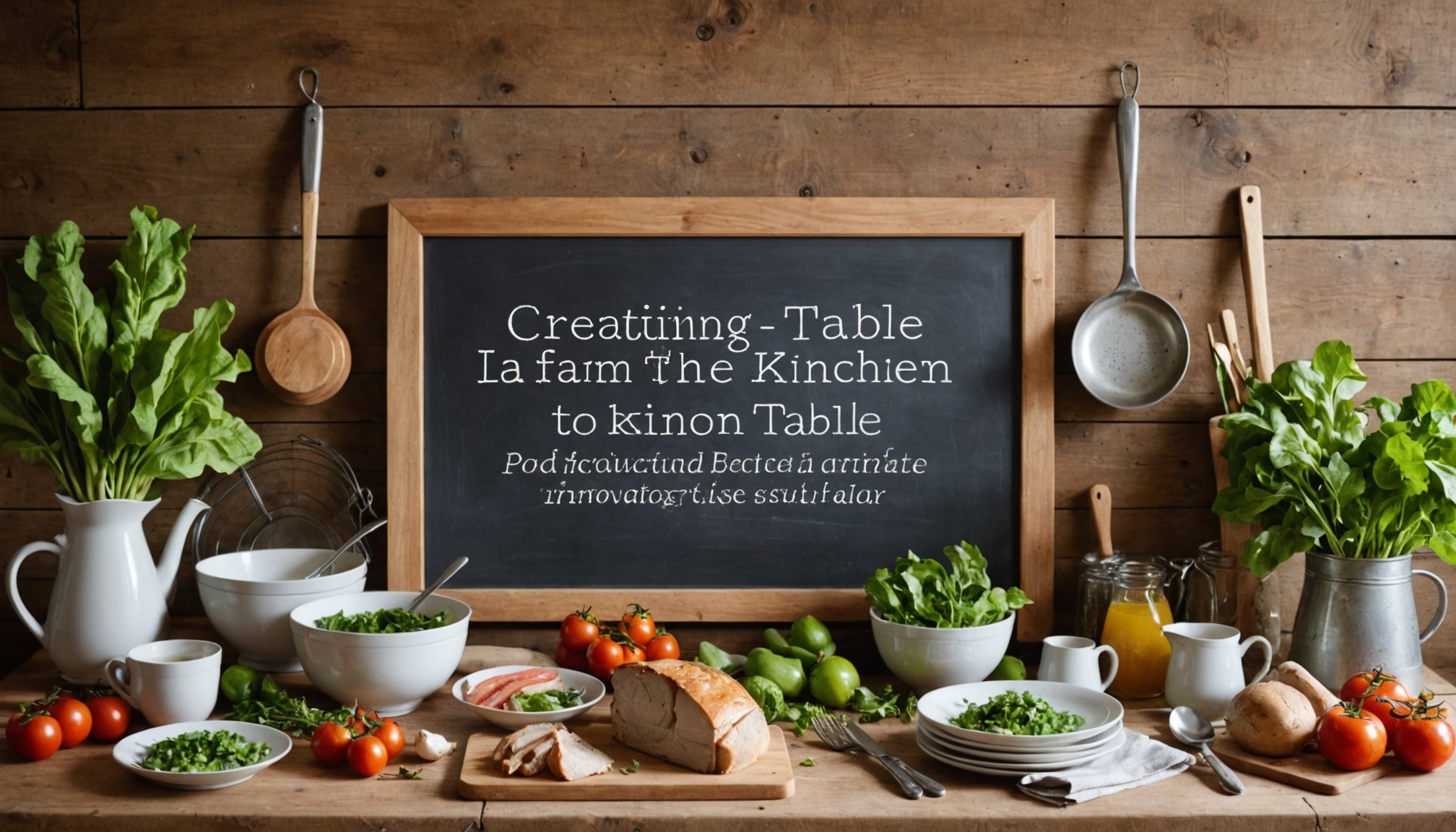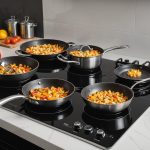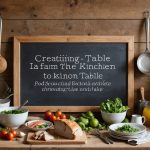Creating a farm-to-table kitchen blends style and sustainability. Design influences how we connect with fresh produce and cooking. This unique space can transform your culinary experience and enhance your commitment to sustainability. From choosing eco-friendly materials to optimizing layout for efficiency, innovative design elevates your kitchen to a hub of creativity. Explore practical tips that will guide you in crafting a kitchen that not only looks beautiful but also supports a healthier lifestyle and environment. Embrace the journey to sustainable living today!
Designing a Sustainable Farm-to-Table Kitchen
Crafting a kitchen that embodies sustainability is essential for those committed to eco-friendly living. A sustainable kitchen design not only minimizes environmental impact but also enhances the overall cooking experience. The importance of sustainability in kitchen design cannot be overstated, as it plays a crucial role in reducing carbon footprints and promoting healthier lifestyles.
Also read : Discover the Benefits of Incorporating Bamboo into Your Kitchen Design: A Sustainable and Stylish Choice
Key Elements of a Farm-to-Table Kitchen
Incorporating eco-friendly materials is a fundamental aspect of sustainable kitchen design. Materials such as reclaimed wood, bamboo, and recycled metals offer durability and a reduced environmental impact. Additionally, innovative layouts that maximize natural light and ventilation contribute to energy efficiency, while also creating a pleasant cooking environment.
- Reclaimed Wood: Durable and environmentally friendly
- Bamboo: Fast-growing and renewable
- Recycled Metals: Sustainable and stylish
Balancing aesthetics with functionality is another vital component. A well-designed farm-to-table kitchen should seamlessly integrate innovative layouts with practical features, ensuring that the space is both beautiful and efficient. This balance can be achieved by carefully selecting eco-friendly materials that complement the overall design while serving practical purposes.
Also to see : Essential Tips for Caring for Your Wooden Kitchen Utensils: Best Practices for Longevity
As the renowned designer William McDonough once said, "Design is the first signal of human intentions." By prioritizing sustainability in kitchen design, individuals can create spaces that reflect their values and support a healthier planet.
Eco-Friendly Materials for Kitchen Construction
Creating a sustainable kitchen begins with the selection of eco-friendly materials. These materials not only reduce environmental impact but also enhance the kitchen's aesthetic and functionality.
Types of Sustainable Materials
Choosing the right sustainable materials is crucial for an eco-friendly construction approach. Reclaimed wood, bamboo, and recycled metals are popular choices. Each offers unique benefits:
- Reclaimed Wood: Known for its durability and charm.
- Bamboo: A fast-growing, renewable resource.
- Recycled Metals: Stylish and sustainable.
These materials ensure that the kitchen is both environmentally responsible and visually appealing.
Benefits of Using Eco-Friendly Products
Using eco-friendly products in kitchen construction has numerous advantages. They help conserve natural resources and reduce carbon footprints. Additionally, these materials often require less energy to produce, leading to lower overall environmental impact.
Moreover, sustainable materials like bamboo and reclaimed wood add a unique character to the kitchen, making it a more inviting space.
Sourcing Locally
Sourcing sustainable materials locally further enhances eco-friendliness. Local sourcing reduces transportation emissions and supports the local economy. By choosing locally available eco-friendly materials, homeowners can ensure their kitchen construction is both sustainable and socially responsible.
Incorporating these practices can significantly contribute to a greener, more sustainable kitchen environment.
Innovative Layouts for Farm-to-Table Kitchens
Crafting a kitchen that optimizes space and functionality.
Open Concept vs. Traditional Layouts
When designing a farm-to-table kitchen, the choice between an open concept and a traditional layout plays a significant role. Open concepts promote a seamless flow between cooking, prep, and dining zones, enhancing interaction and accessibility. In contrast, traditional layouts offer distinct areas, providing privacy and organization. The decision hinges on personal preferences and the kitchen's intended use.
Zones for Cooking, Prep, and Dining
An effective kitchen layout design involves creating specific zones for cooking, preparation, and dining. This strategic division not only optimizes space but also boosts efficiency. For instance, placing the prep area near the refrigerator and the cooking zone close to the dining space can streamline meal preparation and serving.
- Cooking Zone: Near the stove and oven
- Prep Zone: Adjacent to the refrigerator
- Dining Zone: Accessible from the cooking area
Integrating Storage Solutions for Sustainability
Integrating storage solutions is crucial for space optimization and sustainability. Utilizing vertical storage, such as shelves and cabinets, maximizes available space while keeping essentials within reach. Sustainable materials like bamboo or reclaimed wood for storage units not only enhance aesthetics but also align with eco-friendly values. This thoughtful approach ensures a functional kitchen that supports sustainable living.
Incorporating Gardening into Kitchen Design
Incorporating kitchen gardening into your kitchen design not only brings freshness to your meals but also enhances the aesthetic appeal of your space. Indoor gardening allows you to grow your own ingredients, providing a sustainable and convenient source of herbs and vegetables right at your fingertips.
Benefits of Growing Your Own Ingredients
Growing your own ingredients offers numerous benefits. It ensures a steady supply of fresh produce, reduces reliance on store-bought options, and minimizes your carbon footprint. A kitchen garden also promotes healthier eating habits by encouraging the use of fresh, organic ingredients.
- Freshness: Harvest ingredients at their peak
- Sustainability: Lower environmental impact
- Healthier Eating: Access to organic produce
Vertical Gardening Solutions
For those with limited space, vertical gardening solutions are ideal. These systems allow for efficient use of space by utilizing walls or vertical planters. They are perfect for growing herbs and small vegetables, making them a practical addition to any kitchen. Vertical gardens can be customized to fit any kitchen layout, providing both functionality and style.
Best Herbs and Vegetables for Kitchen Gardens
Selecting the best herbs and vegetables for your kitchen garden is crucial. Consider easy-to-grow options like basil, mint, and parsley for herbs. For vegetables, cherry tomatoes and lettuce thrive in indoor settings. These choices ensure a productive and manageable indoor garden.
Creating a Farm-to-Table Aesthetic
Crafting a farm-to-table aesthetic in your kitchen involves thoughtful design choices that evoke the warmth and simplicity of rustic living. By integrating natural elements and organic shapes, you can create a space that feels both inviting and harmonious.
Color Palettes Reflecting Nature
Embrace colors inspired by the earth.
Select a color palette that mirrors the hues of nature—think warm browns, soft greens, and muted blues. These colors not only enhance the rustic design but also create a calming atmosphere. The use of natural tones can help in establishing a connection between the kitchen and the outdoors.
Use of Natural Light and Open Spaces
Maximize light and airiness.
Incorporating natural light is crucial for a genuine farm-to-table feel. Large windows or skylights can flood the kitchen with sunlight, highlighting the beauty of natural elements like wood and stone. Open spaces further enhance the sense of airiness and connection to the environment.
Incorporating Organic Shapes and Materials
Choose materials that echo the earth.
Utilize organic shapes and materials such as stone countertops, wooden beams, and clay tiles. These elements not only support the rustic design but also ensure durability and sustainability. As designer William Morris once said, "Have nothing in your houses that you do not know to be useful or believe to be beautiful."
Practical Tips for Implementing Sustainable Practices
Embrace sustainability with practical solutions.
Energy-efficient Appliances
Investing in energy-efficient appliances is a crucial step towards a sustainable kitchen. These appliances consume less power, reducing both energy bills and environmental impact. Look for devices with the Energy Star label, which signifies high energy efficiency. For instance, an energy-efficient refrigerator can save up to 15% more energy compared to standard models.
Composting and Waste Management Solutions
Implementing composting and waste management solutions can significantly reduce kitchen waste. Start by separating organic waste for composting, which turns food scraps into valuable fertilizer. Use compost bins that fit under the sink for easy access. Additionally, consider waste sorting systems to efficiently manage recyclables and reduce landfill contributions.
- Composting: Convert food scraps into fertilizer
- Waste Sorting: Organize recyclables and landfill waste
- Under-sink Bins: Convenient for daily use
Tips for Local Food Sourcing and Seasonality
Prioritize local food sourcing to support sustainable practices. Buying seasonal produce from local markets reduces transportation emissions and ensures fresher ingredients. Seasonal eating not only supports local farmers but also enhances the nutritional value of meals. Incorporate these practices to align with a sustainable kitchen ethos and enjoy the benefits of fresher, tastier food.













